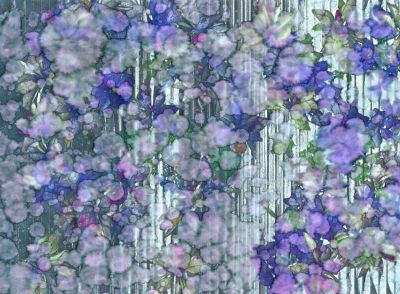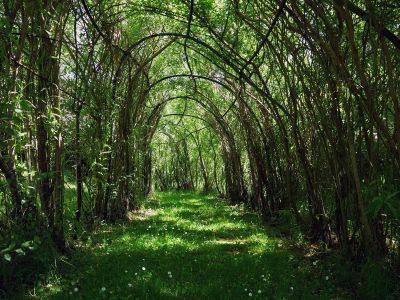Ulrike Crespo
‘I’M PASSIONATE ABOUT MORE THAN ONE THING!’
Psychologist, photographer and philanthropist
Art and culture as constant companions
Photographer, psychologist, benefactor: Ulrike Crespo is much more than the person who established the foundation that bears her name – in fact, her values guide everything that we do. Crespo grew up in a family of industrialists, surrounded by the art collection owned by her grandfather Karl Ströher. She discovered photography and studied art history and archaeology in Switzerland. Her photos of landscapes and plants became her signature form of artistic expression, and she followed her grandfather’s expert advice in collecting contemporary art. In the early 1990s Ulrike Crespo acquired a property in West Cork, Ireland, which she designed as a landscaped park with her partner Michael Satke and then later opened up as a setting for artist residencies.
A deep commitment to social issues and education
In addition to Ulrike Crespo’s appreciation of art, it was primarily her commitment to social issues that determined much of her life. After spending time in Lausanne and Geneva, Crespo taught German in Frankfurt to people who had experienced migration. She was motivated by the desire to enable people to shape their own lives, with a particular focus on those who are disadvantaged. After graduating with a diploma in psychology and taking further vocational training she worked as a psychotherapist from the mid-1990s onwards. The family business was sold in early 2000. Ulrike Crespo wanted to do something meaningful with her inheritance by ‘empowering people’ through her own educational and social projects – and so she set up the Crespo Foundation.
ULRIKE CRESPO’S WORK
The foundation’s four core areas reflect the work undertaken by Ulrike Crespo herself.
Art – The photographer
Ulrike Crespo devoted a great deal of attention to photographing landscapes and plants. She published a number of beautifully designed photography books from 2011 onwards.
Cultural education – Art history and archaeology
Ulrike Crespo studied art history and archaeology in Lausanne and Geneva.
Educational opportunities – The German teacher
Ulrike Crespo taught German as a foreign language in Frankfurt to people who had experienced migration. She was strongly committed to emancipatory ideas as well as the practical concerns and crises that migrants face.
Personal empowerment – The psychotherapist
Ulrike Crespo studied psychology and worked as a psychotherapist in Frankfurt; from 1995 onwards she had her own psychotherapy practice. Her work as a therapist underscored her desire to empower people as individuals.
EXHIBITION
‘FLORALIA: MERIAN – SCHULTZ – CRESPO’
8 Sept.–3 Dec. 2023 at Senckenberg Naturmuseum Frankfurt

The three artists Maria Sybilla Merian (1647–1717), Elisabeth Schultz (1817–1898) and Ulrike Crespo (1950–2019) represent three successive centuries of observing flora – the world of plants. Analysing flora is an important aspect of conducting research into biodiversity. At the same time, plants also belong to the artistic domain. In Frankfurt, these three artists achieved a masterly exploration of art and science in visual form. The exhibition at Seckenberg Naturmuseum presents their works in an entirely new context, shedding light on the relationship between science and art.
About the ‘Rainflowers’
Ulrike Crespo’s ‘Rainflowers’ are indivisibly linked to Glenkeen Garden, a park with different zones that have been variously landscaped or left in a natural state. Situated on the coast of West Cork, Ireland, Glenkeen Garden was designed by the artist and her partner Michael Satke over a period of many years. She sought to get close to plants not only through photographs but also at an experimental level.
Individual blossoms or leaves serve as her material for the ‘Rainflowers’; over 200 of them were arranged directly on the scanning platen of a colour copier and the printed copies were then subsequently exposed to the weather. The typically Irish drizzle dissolved the colours to a greater or lesser degree, which is what gives her works their unique, abstract effects. Crespo then scanned the motifs once more in order to complete the process digitally. Her ‘Rainflowers’ shift the focus to the interaction between an exact digital record and the random patterns created by natural elements. The artist took an open approach to the final format used for these motifs, depending on the venue and function: they might take up the entire wall or be presented as a framed work of art.
‘Their works express a curiosity, an urge to discover things, and a patient attention to detail in natural spaces and when observing correlations.’
‘Their works express a curiosity, an urge to discover things, and a patient attention to detail in natural spaces and when observing correlations.’
Glenkeen Garden
Documentary about Ulrike Crespo’s landscaped park in West Cork, Ireland

Christiana Cheiranagnostaki – Konstanza Kapsali, Glenkeen Garden, 2023, all rights reserved
EXHIBITION
BLICKE HINTER DAS NATURSCHÖNE – DIE FOTOBÜCHER VON ULRIKE CRESPO (Looking Behind Natural Beauty – Ulrike Crespo’s Photography Books)
19 Oct.–12 Nov. 2022 at Crespo Studio, Frankfurt

Ulrike Crespo’s fifteen books of photography were presented in an exhibition for the first time in 2022. The artist experimented with various camera techniques and perspectives for her series of photographs, many of which were taken on her travels. Thematically she concentrated on landscapes as a macrocosmos and plants as a microcosmos.
Crespo’s wasn’t aiming to have her photos shown in a museum – her art was motivated by a more democratic desire: she wanted a photo to be a page in a book so that everybody could participate in her experiments and expeditions. Her books were designed in conjunction with the renowned graphic designer Harald Pridgar.
‘…I think she was looking for something with her photos, something otherworldly, beyond her life, – a counterpoint – a world where things were different.’
‘…I think she was looking for something with her photos, something otherworldly, beyond her life, – a counterpoint – a world where things were different.’
EXHIBITION
Ulli Crespo – GRÖNLAND EISKALT (Ice Cold Greenland)
20 Mar.–11 Apr. 2021 at MMK Zollamt, Frankfurt
Exhibition and presentation of the Ulrike Crespo bequest
at MUSEUM MMK FÜR MODERNE KUNST

Photographs from the Greenland series
In 2021, the Crespo Foundation presented the photography exhibition ‘ULLI CRESPO GRÖNLAND EISKALT’ at MMK Zollamt in Frankfurt, featuring photos from Ulrike Crespo’s Greenland series. Taken on a journey to Greenland in summer 2015, they document the Arctic landscape along the east coast from Maniitsoq via Kangaamiut and Sisimiut to Ilulissat and the Russell Glacier in central western Greenland, near Kangerlussuaq. The exhibition was forced to close only ten days after the opening on account of the Covid pandemic.
‘…you have to imagine them [the pictures] as if you were passing by on a ship – it has to be confusing, it has to be random, it has to be arbitrary.’
‘…you have to imagine them [the pictures] as if you were passing by on a ship – it has to be confusing, it has to be random, it has to be arbitrary.’
Bequest of contemporary artworks
The Crespo Foundation simultaneously presented a generous bequest from Ulrike Crespo to MUSEUM MMK FÜR MODERNE KUNST. Ulrike Crespo bequeathed a number of works to the museum from her extensive collection of contemporary art. The gift includes paintings, drawings, photographs and sculptures by Ilija Bosilj Bašičević, Thomas Bayrle, Joseph Beuys, Miriam Cahn, Walter Dahn, Peter Dreher, Ellsworth Kelly, Teresa Margolles, Meuser, A.R. Penck, Tobias Rehberger, Jeff Wall, Andy Warhol and Franz West.